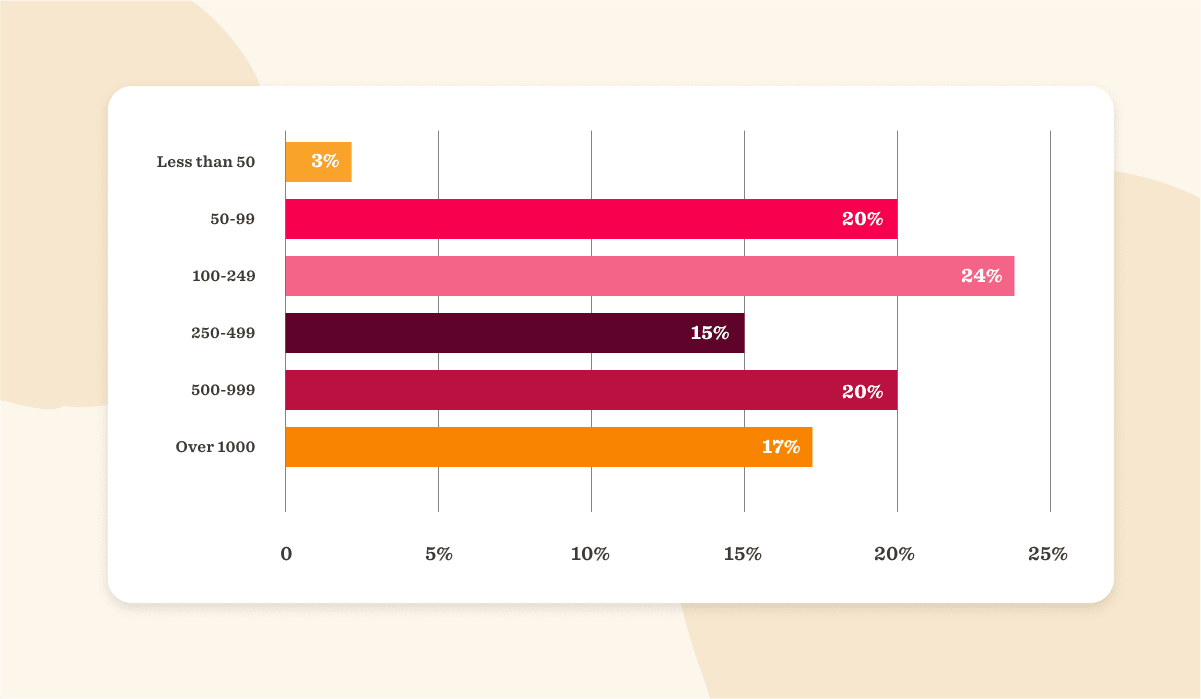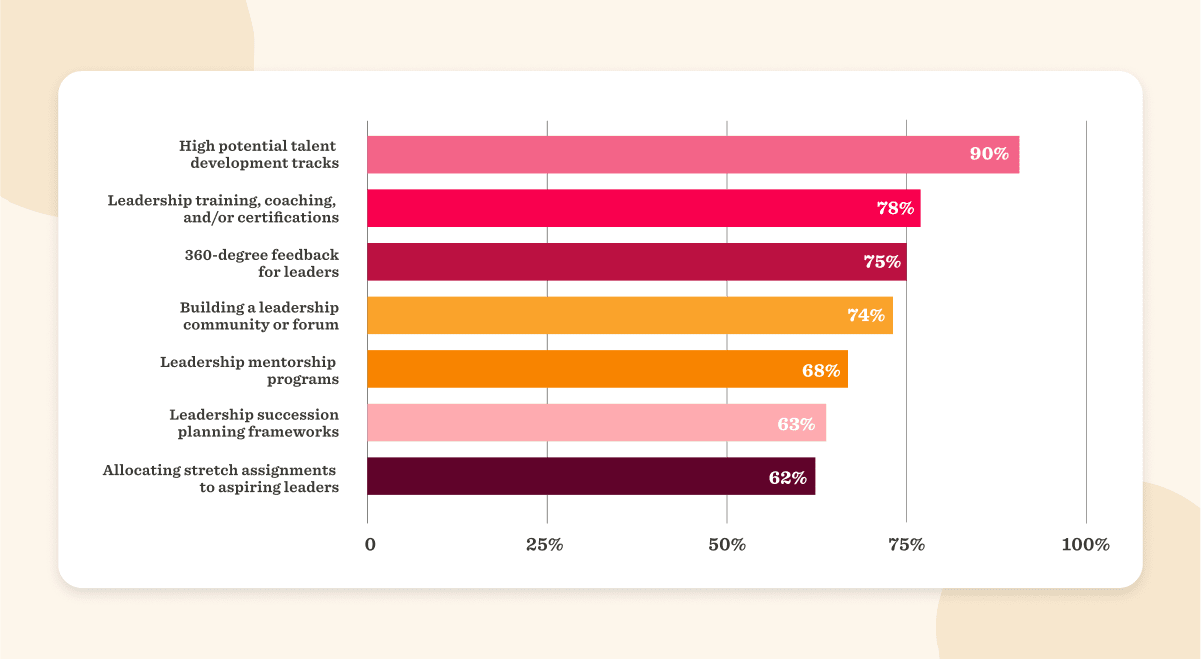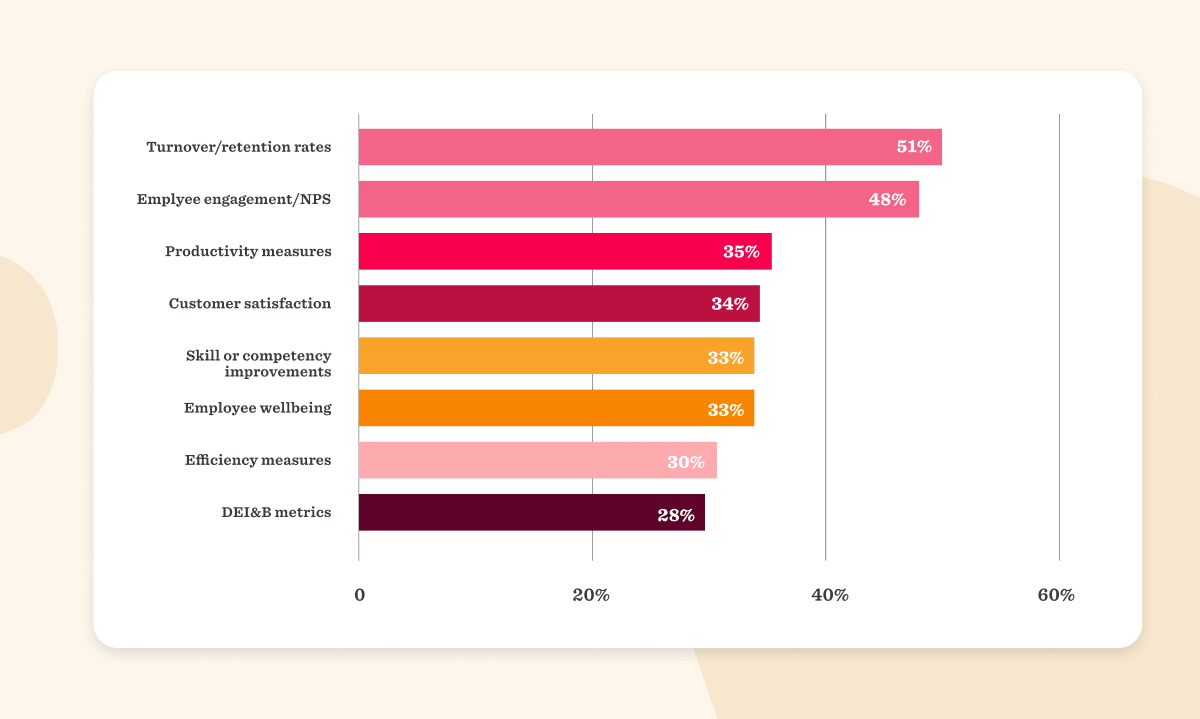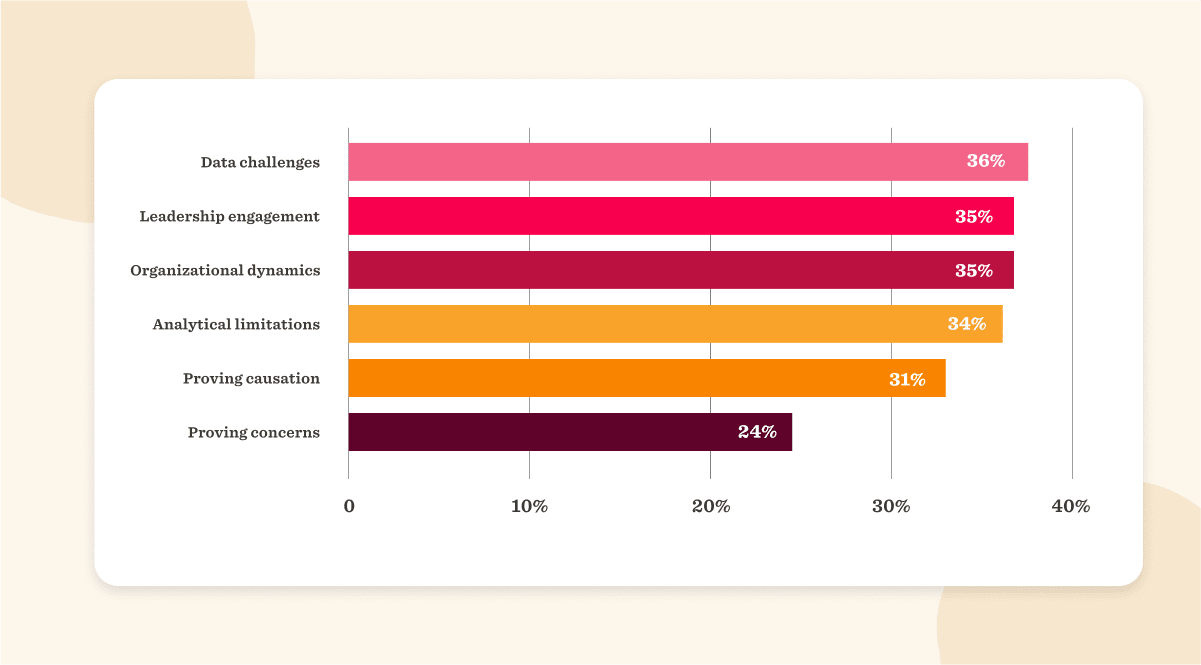For HR leaders in small and mid-sized businesses (SMBs), investing in leadership development often feels like a tough sell. With tight budgets and competing priorities, does leadership training pay off?
The data says yes. Studies show that for every $1 spent on leadership training, businesses see up to $4.15 in return, with some analyses suggesting an even higher ROI. And it’s not just about the money. Employees with ineffective managers are five times more likely to consider leaving than those with strong leadership.
In this blog, we’ll break down key benchmarks proving leadership development isn’t an expense but an investment. We’ll explore the numbers, the impact, and the leadership strategies that drive business success.
Let’s review the data and get some benchmarks you can stand behind for your leadership programs.
<<Read the full report ‘Data and insights on the HR investments that drive business impact’ here.>>
Why invest in leadership development?
When it comes to leadership development, the data makes one thing clear: investing in leadership training delivers measurable returns.
Research shows that first-time manager training delivers a 29 percent ROI in three months and a 415 percent annual return. This means that for every $1 spent, businesses gained $4.15 back. Some estimates suggest an even higher impact, with returns reaching $7 for every $1 invested.
But leadership training isn’t just about financial gains. Strong leadership has a direct impact on employee retention and engagement. The data shows that employees who report to ineffective managers are five times more likely to consider leaving than those with effective leaders. Poor leadership leads to frustration, low morale, and, eventually, turnover.
For small and mid-sized businesses, where every hire matters, building strong leadership isn’t a luxury—it’s a necessity. Investing in leadership development helps companies retain top talent, boost performance, and create a workplace where people want to stay and grow.
The bottom line? Leadership training is one of the smartest investments HR can make. The right programs don’t just develop better managers—they drive business success.
With such a clear business case for leadership development, how are small and mid-sized companies approaching it? The data reveals some interesting workforce trends.
How SMBs approach leadership development with insights from our survey
Most research on leadership development focuses on large enterprises with extensive training programs and resources. But how do small and mid-sized businesses (SMBs) approach leadership training? We surveyed 293 HR and C-suite leaders across SMBs worldwide to answer this.
Worldwide survey: Company size and number of employees

Our goal was to uncover how smaller organizations invest in leadership development, what programs they prioritize, and how they measure success. The survey included a diverse mix of respondents:
- 36 percent HiBob customers, 64 percent non-customers
- 61 percent from the U.S., 19 percent from the UK, and 20 percent from Europe and Australia
Unlike large enterprises, SMBs must take a strategic approach to leadership education programs, balancing immediate business needs with long-term development goals. While companies are making deliberate choices about leadership programs, many still struggle to measure impact and prove ROI.
So, which leadership strategies are SMBs using, and what impact do they have? Here’s what the data shows.
The most common leadership development strategies and their impact
The most widely used approach, by about 12 percentage points, is high-potential talent development tracks. Many SMBs prioritize clear pathways for rising leaders, ensuring top performers access structured growth opportunities through executive leadership programs and internal development initiatives.
Recommended For Further Reading
Top programs used by SMBs

Other common leadership development efforts include:
- Formal and informal feedback programs
- Training and certifications
- 360-degree feedback assessments
- Leadership peer networks
- Mentorship programs
- Succession planning and stretch assignments
Many companies are strengthening leadership skills by offering opportunities for leaders to learn and grow while still on the job.
But we didn’t just want to know what companies were doing. We wanted to see whether these programs were making a real impact.
The results were clear. Between 70 and 83 percent of companies said leadership programs improved their organization, while 22 percent said they had no effect. No more than 5 percent reported a negative impact.
Degree of program impact

Given the ROI of leadership training, this wasn’t surprising. But we wanted to go further. We asked companies what had improved due to these programs, and that’s when things got interesting.
Companies that invested in leadership training reported measurable improvements in three key areas:
- Enhanced team collaboration (57 percent): Respondents believed that employees worked more effectively together, had clearer expectations, and communicated more openly
- Improved employee satisfaction and engagement (55 percent): Respondents believed teams led by trained managers had higher motivation, stronger connections to leadership, and greater confidence in their roles
- Improved employee performance (47 percent): Respondents noted that leadership development helped employees become more productive, take ownership of their work, and contribute more effectively to company goals
Business areas impacted by leadership training in the past year

Specific programs stood out. Coaching and mentorship would align with helping managers develop stronger decision-making and communication skills, while 360-degree feedback and leadership peer networks likely played a key role in accountability and self-awareness.
For HR leaders in SMBs, leadership development is more than a best practice. It delivers real business results. Companies that invest in leadership training aren’t just improving managers but strengthening retention and setting up their organizations for long-term success.
Why leadership development is still a hard sell
Even with our latest research and insights, many HR leaders may still struggle to secure buy-in for leadership training. If the ROI of leadership development is so clear, why is it still such a hard sell?
The challenge often comes down to measurement. Many HR teams lack the internal metrics needed to prove the direct impact of leadership development within their own organizations. Without solid data to back up these initiatives, building a compelling case for investment becomes harder.
The data gap in leadership development metrics
Our survey found that only half of HR leaders use engagement and turnover data to justify leadership development initiatives. The numbers drop even lower when tracking other key metrics, such as performance improvement or leadership effectiveness.
Top metrics used in HR

This raises an important question: If leadership training is so impactful, why are so few organizations using data to support it? Several challenges contribute to this gap:
- Limited tracking capabilities. Many HR teams do not have the tools to measure leadership development outcomes effectively.
- Unclear connections between leadership training and retention. While turnover and engagement are commonly tracked, they are not always tied directly to leadership training efforts.
- Leadership buy-in. Executives may want more concrete proof before investing in leadership programs, but HR often lacks the ability to provide detailed analytics.
Why engagement and turnover metrics alone are not enough
Focusing heavily on turnover and engagement metrics presents another challenge in the current economic uncertainty.
Various organizations tracking engagement and turnover trends have noted a disconnect between employee sentiment and behavior. For example:
- In the U.S., Gallup reports that engagement is at an all-time low, yet turnover isn’t spiking. Many employees are disengaged but stay put due to economic conditions and uncertainty in the job market.
- In EMEA, Qualtrics found that engagement has increased by two points, but intent to stay has dropped by five points. Even as employees report feeling more engaged, they consider leaving, possibly in response to an ongoing cost of living crisis and the need to prioritize pay above satisfaction.
Why does this matter? While engagement surveys are an easy and valuable tool for HR to leverage as support for leadership development and other programs, they are likely to be less persuasive than usual. This dynamic manifests in efforts to force unpopular policies like blanket Return-to-office (RTO) mandates and cuts to employee experience “perks” despite employee pushback.
If the economy causes people to follow money over their feelings, executives have less reason to value engagement data when making decisions. If people don’t leave when they are disengaged or stay when they are engaged, what’s the point of engagement measures billed as leading indicators of turnover?
HR teams looking to justify their investments in leadership development will need to diversify their metrics to ensure they have persuasive arguments for these investments until this disruption passes.
What this means for leadership development
If engagement is no longer the most reliable predictor of turnover, where should HR leaders focus their attention to justify continued investment in leadership development?
One place to start is employee performance. HR teams can compare teams led by managers who have received leadership training with those who haven’t. Are the developed teams meeting goals more consistently? Are they delivering better results or staying on a budget more often? These kinds of comparisons can provide concrete evidence of the impact of leadership development on business outcomes.
Another approach is to expand the use of surveys. Beyond engagement, surveys can be a tool for exploring collaboration and leadership quality. Do people on well-developed teams report more productive meetings and better cross-functional cooperation? Are trained leaders rated more highly by their teams and stakeholders? Even if executives are less focused on engagement or turnover in the short term, they are often receptive to data about leadership quality and team performance.
It sounds simple, but making this shift in measurement and mindset can be challenging. For many organizations, it means revisiting what gets tracked, how success is defined, and what data is shared with leadership.
Overcoming the measurement gap in leadership development
Many organizations struggle to measure the impact of leadership development or connect it to broader business goals. The challenge goes beyond basic data collection and touches on deeper organizational issues that make it difficult to track leadership training outcomes effectively.
Some of the key challenges include:
- Data Challenges. Many organizations don’t proactively collect the right data, question the quality of the data they collect, or have siloed data systems. Focused on easy engagement surveys and HR-centric turnover data, they either lack other metrics or struggle to slice that data by relevant leadership cohorts (e.g., trained vs. untrained).
- Leadership buy-in. Executives may be skeptical about HR data, making it harder to justify ongoing investments in leadership training.
- Analytical limitations. HR teams may lack the tools or expertise to link leadership development to business outcomes.
- Data privacy concerns. Due to compliance risks, companies may hesitate to collect or share leadership effectiveness data.
Data collection challenges

To make a stronger case for leadership development, HR needs to rethink how they measure success, ensure that leadership training aligns with business priorities, and launch programs with an explicit validation approach already in mind. Too often, HR programs launch before considering how to measure their effectiveness, and it’s usually too late to build those data streams after the launch. Here are some practical ways to approach this taken from our HR strategy & business alignment workbook:
- Track multiple metrics selected for their relevance to the initiatives, not just engagement. Retention rates, team collaboration, and leadership effectiveness should all be part of the evaluation process for leadership programs.
- Invest in a multi-metric HCM system. A centralized platform can improve data collection and security while making insights more accessible.
- Outsource critical analytics projects. Partnering with external experts can help HR teams analyze leadership impact more effectively.
- Align leadership training with executive priorities. If business leaders care about productivity or customer satisfaction, frame leadership development as a driver of those outcomes.
- Make sure you can view key outcome data through the lens of participation in your leadership programs. Phased rollouts are the best resource management option and provide opportunities to demonstrate a program’s impact.
- Use organizational shifts as an opportunity. Changes like restructuring or new strategic goals can be a natural moment to introduce better leadership measurement practices.
Leadership training works, but companies that do not measure the right outcomes in the right ways will struggle to prove its value. By refining how leadership impact is tracked and communicated, HR leaders can strengthen their case for investment and ensure that leadership programs deliver results.
Now is the time to invest in leadership
Investing in leadership development is more than just a professional growth initiative. The data shows that when organizations invest in training their leaders, they see real business results. Stronger leadership improves collaboration, increases employee satisfaction, and reduces turnover.
For small and mid-sized businesses, making the right leadership investments can be a challenge, especially when resources are limited. However, the research confirms that effective leadership training is one of the most impactful ways to drive long-term success.
The next step is yours. Use these benchmarks to evaluate your leadership programs and invest in strategies to strengthen your organization’s future.
<<Read the full report ‘Data and insights on the HR investments that drive business impact’ here.>>


